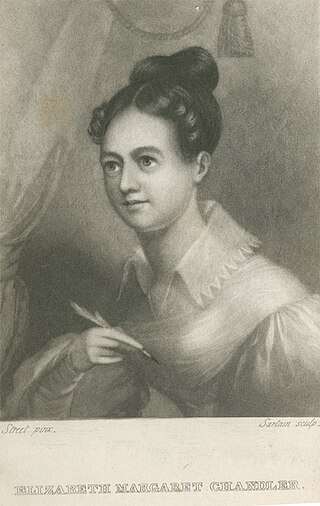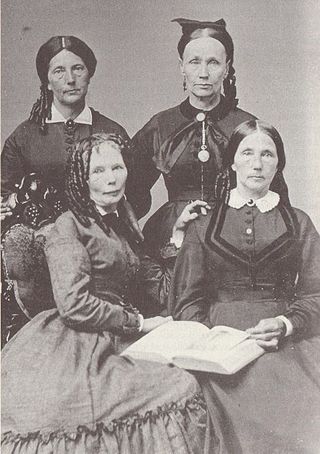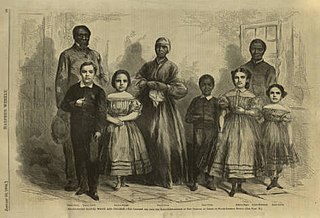The slave narrative is a type of literary genre involving the (written) autobiographical accounts of enslaved persons, particularly Africans enslaved in the Americas, though many other examples exist. Over six thousand such narratives are estimated to exist; about 150 narratives were published as separate books or pamphlets. In the United States during the Great Depression (1930s), more than 2,300 additional oral histories on life during slavery were collected by writers sponsored and published by the Works Progress Administration, a New Deal program. Most of the 26 audio-recorded interviews are held by the Library of Congress.

Lydia Maria Child was an American abolitionist, women's rights activist, Native American rights activist, novelist, journalist, and opponent of American expansionism. Her journals, both fiction and domestic manuals, reached wide audiences from the 1820s through the 1850s. At times she shocked her audience as she tried to take on issues of both male dominance and white supremacy in some of her stories.

William Still was an African-American abolitionist based in Philadelphia, Pennsylvania. He was a conductor of the Underground Railroad and was responsible for aiding and assisting at least 649 slaves to freedom towards North. Still was also a businessman, writer, historian and civil rights activist. Before the American Civil War, Still was chairman of the Vigilance Committee of the Pennsylvania Anti-Slavery Society, named the Vigilant Association of Philadelphia. He directly aided fugitive slaves and also kept records of the people served in order to help families reunite.

Frances Ellen Watkins Harper was an American abolitionist, suffragist, poet, temperance activist, teacher, public speaker, and writer. Beginning in 1845, she was one of the first African American women to be published in the United States.

Incidents in the Life of a Slave Girl, written by herself is an autobiography by Harriet Jacobs, a mother and fugitive slave, published in 1861 by L. Maria Child, who edited the book for its author. Jacobs used the pseudonym Linda Brent. The book documents Jacobs's life as a slave and how she gained freedom for herself and for her children. Jacobs contributed to the genre of slave narrative by using the techniques of sentimental novels "to address race and gender issues." She explores the struggles and sexual abuse that female slaves faced as well as their efforts to practice motherhood and protect their children when their children might be sold away.
African American literature is the body of literature produced in the United States by writers of African descent. It begins with the works of such late 18th-century writers as Phillis Wheatley. Before the high point of enslaved people narratives, African American literature was dominated by autobiographical spiritual narratives. The genre known as slave narratives in the 19th century were accounts by people who had generally escaped from slavery, about their journeys to freedom and ways they claimed their lives. The Harlem Renaissance of the 1920s was a great period of flowering in literature and the arts, influenced both by writers who came North in the Great Migration and those who were immigrants from Jamaica and other Caribbean islands. African American writers have been recognized by the highest awards, including the Nobel Prize given to Toni Morrison in 1993. Among the themes and issues explored in this literature are the role of African Americans within the larger American society, African American culture, racism, slavery, and social equality. African-American writing has tended to incorporate oral forms, such as spirituals, sermons, gospel music, blues, or rap.

Clotel; or, The President's Daughter: A Narrative of Slave Life in the United States is an 1853 novel by United States author and playwright William Wells Brown about Clotel and her sister, fictional slave daughters of Thomas Jefferson. Brown, who escaped from slavery in 1834 at the age of 20, published the book in London. He was staying after a lecture tour to evade possible recapture due to the 1850 Fugitive Slave Act. Set in the early nineteenth century, it is considered the first novel published by an African American and is set in the United States. Three additional versions were published through 1867.

Iola Leroy, or Shadows Uplifted, an 1892 novel by Frances E. W. Harper, is one of the first novels published by an African-American woman. While following what has been termed the "sentimental" conventions of late nineteenth-century writing about women, it also deals with serious social issues of education for women, passing, miscegenation, abolition, reconstruction, temperance, and social responsibility.

"Bury Me in a Free Land" is a poem by African-American writer and abolitionist Frances Harper, written for The Anti-Slavery Bugle newspaper in 1858.

Elizabeth Margaret Chandler was an American poet and writer from Pennsylvania and Michigan. She became the first female writer in the United States to make the abolition of slavery her principal theme.

Frances Dana Barker Gage was a leading American reformer, feminist and abolitionist. She worked closely with Susan B. Anthony and Elizabeth Cady Stanton, along with other leaders of the early women's rights movement in the United States. She was among the first to champion voting rights for all citizens without regard to race or gender and was a particularly outspoken supporter of giving newly freed African American women the franchise during Reconstruction, along with African American men who had formerly been slaves.

The Frances Ellen Watkins Harper House is a historic row house at 1006 Bainbridge Street in Philadelphia, Pennsylvania, USA. Of uncertain construction date, it was the home of Frances Ellen Watkins Harper (1825-1911) from 1870 until her death. Harper was a prominent African-American abolitionist, women's rights and civil rights activist, and author. It was designated a National Historic Landmark in 1976.

The free-produce movement was an international boycott of goods produced by slave labor. It was used by the abolitionist movement as a non-violent way for individuals, including the disenfranchised, to fight slavery.

Delia Ann Webster was an American teacher, author, businesswoman and abolitionist in Kentucky who, with Calvin Fairbank, aided many slaves, including Lewis Hayden, his wife Harriet, and their son Joseph to escape to Ohio. She was convicted and sentenced to two years in the Kentucky State Penitentiary in Frankfort for aiding the Haydens' escape, but pardoned after two months.

White slave propaganda was a kind of publicity, especially photograph and woodcuts, and also novels, articles, and popular lectures, about slaves who were biracial or white in appearance. Their examples were used during and prior to the American Civil War to further the abolitionist cause and to raise money for the education of former slaves.

Harriet Forten Purvis was an African-American abolitionist and first generation suffragist. With her mother and sisters, she formed the first biracial women's abolitionist group, the Philadelphia Female Anti-Slavery Society. She hosted anti-slavery events at her home and with her husband Robert Purvis ran an Underground Railroad station. Robert and Harriet also founded the Gilbert Lyceum. She fought against segregation and for the right for blacks to vote after the Civil War.
Sarah Louisa Forten Purvis (1814–1884) was an American poet and abolitionist from Philadelphia, Pennsylvania. She co-founded The Philadelphia Female Anti-Slavery Society and contributed many poems to the anti-slavery newspaper The Liberator.

James Watkins, was an African American author and abolitionist. After managing to escape from slavery, Watkins travelled to the United Kingdom, where he gave several lectures against American slavery.
William J. Watkins Sr. was an African-American abolitionist, educator, and minister from Baltimore, Maryland.
Abolitionist children’s literature includes works written for children by authors committed to the movement to end slavery. It aimed to instill in young readers an understanding of slavery, racial hierarchies, sympathy for the enslaved, and a desire for emancipation. A variety of literary forms were used by abolitionist children’s authors including, short stories, poems, songs, nursery rhymes and dialogues, much of it written by white women. Pamphlets, picture books and periodicals were the primary forms of abolitionist children’s literature, often using Biblical themes to reinforce the wickedness of slavery. Abolitionist children's literature was countered with pro-slavery material aimed at children, which attempting to depict slavery as a noble pursuit, and slaves as stupid and grateful, or evil.















